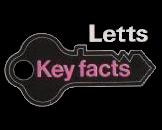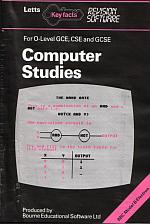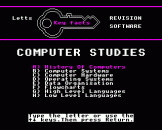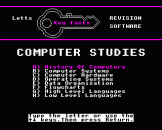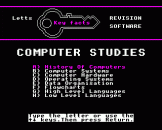Introduction
Computer-based techniques can lead a student to a clearer understanding of problem areas in a subject. The Letts Keyfacts Software series provides suites of programs specifically designed to develop insight into these areas of difficulty. Each package contains up to 10 interactive programs based on major topics found in all the current 16+ (O-Level GCE, CSE and GCSE) syllabuses.
As an integral part of a revision scheme, the programs will assist understanding and reinforce learning. A variety of approaches is used to maximise the student's interest and to introduce an element of enjoyment to home study. Graphics are presented in an imaginative, interactive way as a positive teaching aid. An illustrated booklet provides information on how to get the most out of the programs.
Computer Studies consists of ten interactive programs, approved by subject teachers and tested by students are contained on two cassette tapes. Topics included are:
- History of computers and information processing
- Computer systems
- Input and output devices, storage media
- Flowcharts
- High-level languages
- Low-level languages
- Operating systems and systems software
- Data organisation
- Bit representation of data
- Digital logic
The Programs
The programs on these cassette tapes have been divided to make your revision more approachable and enjoyable. Organisation is the key to making the most of your revision time. For each subject follow these simple rules.
| 1. | Know your syllabus. A quick reference to the relevant syllabus analysis table to be found at the front of the Letts Study Aid Revise series is advised. |
| 2. | Devise a timetable, as soon as the mocks are over, which will allow you to go through the syllabus at least twice (more for problem areas). |
| 3. | For each topic, read all your available material - class notes and textbooks. Make summary notes as you go, then test yourself. Keyfacts Multiple Choice or Letts Study Aids Objective Questions will give invaluable practice and help. Finally, run the relevant computer program which will both test your knowledge and give you another perspective. |
| 4. | Just before the examination, use all your summary notes to jog your memory and the whole subject program suite to reinforce your understanding. |
The Computer Studies revision programs fall into three categories:
| a. | those which revise many of the different aspects of computer systems |
| b. | those which revise your software development skills |
| and | |
| c. | two programs to assist you in revising techniques fundamental to the subject, e.g. analysis of logic circuits. |
As you commence your revision scheme you will find the programs an invaluable aid, helping you to learn and understand much information in an interesting and stimulating way. Then as your revision progresses you can test yourself and monitor your progress.
|
Tape 1 Side A
The history of computers and information processing ("HISTORY") Computer systems ("SYSTEMS") Computer hardware ("HARDWRE") |
Tape 1 Side B
Operating systems ("OPSYS") Data organisation ("DATAORG") |
| Tape 2 Side A Flowcharts ("FLOWCHT") High level languages ("HIGHLL") Low level languages ("LOWLL") |
Tape 2 Side B Logic circuits ("LOGIC") Number systems ("NUMBER") |
The Programs
1. The History of Computers and Information Processing
The first screen displays a menu of:
| 1. | Calculating Machines | |
| 2. | Stored Program Computers | |
| 3. | Software and Programming Languages | |
| 4. | Storage of Programs and Data | |
| 5. | Set the time limit |
from which you are invited to make a selection. The default time limit, the time you have to make a match, is two seconds, which can be altered by selecting option 5.
If you select one of options 1-4 a list of dates appears down the left-hand side of the display. You are asked to match the events given at the top of the screen with a date. When you are ready, press the SPACE Bar - this causes an arrow to cycle down the screen.
When you think the arrow is aligned with the correct date, press any key (except the red function keys). If you make a correct selection the event is inserted into the list. If you make an incorrect match, the arrow reappears and continues moving so you can try again.
If you make two incorrect selections or the arrow cycles round the screen three times without the correct match being made the event is added to the list for you.
2. Computer Systems
This program helps you revise the architecture of a typical digital computer and the CPU. As you answer specific questions, a diagrammatic representation of a typical digital computer, showing the main control and data flows, is constructed. The questions are presented one at a time with the answers represented by dashes, one per letter, except for the yes/no answers which are left blank. After two incorrect attempts the correct answer is given.
If you choose to revise the CPU the computer draws a block diagram showing the main components of the CPU, and the control and data flows. You are asked to label the blocks by replacing the dashes. When you have completed the diagram, any incorrectly labelled blocks are identified and the correct solutions displayed.
3. Computer Hardware
This topic is revised in two parts. The first requires you to classify eighteen items correctly under one of the following heading:
| A. | Input | ||
| B. | Output | ||
| C. | Input and Output | ||
| D. | Storage |
If you think that any of the items could be classified under more than one heading then select the one that fits best.
If you classify an item correctly the item will be added to a table. If after two attempts you have not arrived at the correct solution the item is added to the table for you.
Three types of hardware are revised in part two of the program. These are:
| 1. | Input Devices | ||
| 2. | Output Devices | ||
| 3. | Backing Store |
When you have made your selection a passage, with some keywords missing, appears on the screen. You are asked to complete the passage filling in the missing words. The words must be entered in order - press RETURN to move to the next word. When the passage is complete, your score is displayed and you are invited to review the answers.
4. Operating Systems
The first screen displays the following menu:
| 1. | Operating Systems and System Software | ||
| 2. | Types of Operating Systems |
from which you are invited to make a selection.
The first option gives you the choice of Operating Systems or Systems Software. When you have chosen one, a passage, with keywords replaced by dashes, appears on the screen. You are asked to complete the passage filling in the missing words. The words must be entered in order - press RETURN to move to the next word. When the passage is complete your score is displayed and you are invited to review the correct answers.
The second option tests your knowledge of different types of operating systems and hardware configurations. Three diagrams are displayed in turn and you are asked to identify each system. If you give a wrong answer a clue is given. If you are still unable to identify the system after two clues have been given the correct answer and another characteristic are displayed.
5. Data Organisation
The first screen displays a menu of:
| 1. | File Structure | ||
| 2. | Data Preparation and Organisation |
from which you are invited to make a selection.
By selecting the first option and answering the questions set a representation of a file and the organisation of data within the file is constructed. The questions are presented one at a time, with the answers substituted by dashes. You are given two attempts substituted by dashes. You are given two attempts to reach the correct answer, after which it is displayed for you.
The major part of this topic is revised using a series of multiple choice questions which cover all aspects of data preparation and organisation. You can choose to answer all the questions before seeing the correct solutions or to have your answers checked as you go along. In either case when you have attempted all the questions, your score is displayed and you are invited to review the questions and answers. Finaly your score is analysed by subtopic so you can identify any areas of weakness.
6. Flowcharts
The computer draws a flow chart and an outline of a table. You are asked to complete the table for a particular point in the flowchart, deducing whether the stopping condition has been satisfied and calculating the value of a variable. The computer automatically selects the input data for you.
You have two chances to calculate the variable value correctly, and one to deduce whether or not the stopping condition is satisfied (a yes/no answer). If you fail to reach the correct answer the computer will fill in the correct solution for you.
When you have completed the flow charts for six different problems your score and performance are assessed.
7. High-Level Languages
This program allows you to revise some of the major features of high level languages. These have been divided into four groups:
| 1. | Expressions and Assignments | ||
| 2. | Branches and Loops | ||
| 3. | Subroutines and Functions | ||
| 4. | Strings |
one of which you are invited to choose. When you have made your selection five problems, which consist of a question based on a short BBC Basic program segment, are set.
You are given two attempts to answer the question correctly. If after two attempts you have not deduced the correct solution, the computer illustrates how it is arrived at, with the aid of a trace table.
An arrow indicates the flow of control through the program segment. When the line highlighted by the arrow has been executed the values of relevant variables are given in the trace table. When a line of code has been executed, press the SPACE Bar to move to the next one.
8. Low Level Languages
This program allows you to revise the characteristics of low level languages and assembly language programming. You make your selection from the menu on the first screen.
If you choose the first option the computer draws a table, with some of the entries replaced by dashes, one word per line. You are invited to complete the table. If you have difficulty in filling in an entry type '?' and it will be filled in for you.
The second option displays a small section of assembly language code, resident in the memory of a simple computer. You are asked to calculate the value that would be stored in a particular memory location after the section of code has been executed. When you have answered the question, the execution of the program is simulated, showing the flow of information between the registers and memory.
9. Logic Circuits
The first screen displays a menu:
| 1. | Revise the NOT, AND and OR gates | ||
| 2. | Revise the NAND, NOR and EOR gates | ||
| 3. | Analyse Simple Logic Circuits |
You are invited to select from 1-3.
If you select options 1 or 2 you then choose the gate you wish to revise. When you have made your selection the computer draws a representation of the gate and outlines the logic table to be completed, positioning the cursor ready for your first entry. All the entries are either one or zero. If you do not complete the table correctly you are given the option of seeing the correct solution or having a further attempt. To return to the menu on the first screen simply press ESCAPE.
If you choose the third option, the computer draws a circuit and specifies the inputs. You are asked to calculate the output. If the answer you give is incorrect you are given the option of seeing how the correct solution is arrived at. When you have analysed five circuits your score is displayed.
10. Number Systems
This topic has been divided into three areas:
| 1. | Binary and Decimal Positive Integers | ||
| 2. | Negative Integers, Addition and Subtraction | ||
| 3. | Octal and Hexadecimal |
You are invited to select one from the menu displayed on the first screen.
The first option investigates the conversion of integers from decimal to binary and vice versa. When you have chosen the type of conversion, the program sets ten problems. If you fail to reach the correct solution to a problem after two attempts the program guides you through the conversion process. When you have attempted all ten problems your score is displayed.
Option two introduces negative integers and simple computer arithmetic. The options are displayed in a menu and you are invited to choose one.
Again you are given two attempts to calculate the correct solution to each problem after which the program guides you through the converstion process or, if you are revising Addition and Subtraction, displays the correct answer. Your score is presented when you have tried all ten problems.
The final option, which lets you practice conversions from binary to octal and hexadecimal and vice versa, is similar to option one.
